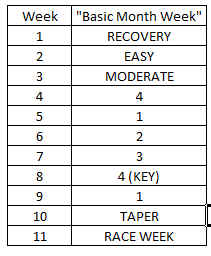No one has recovery dialed like that cat.
I mentioned in my posts about my Cozumel plan that I want to focus more on recovery, then I said my new plan isn't going to have any recovery weeks. My goal was to go with a more moderate build and include more rest within the weeks.
I picked up the new issue of Triathlete Magazine and there was a qualify for Kona 7-week training plan. I looked it over, but couldn't quite get a handle on how hard it was. It looked like there were a lot of big days, but big days aren't necessarily hard days if the intensity isn't high.
I decided to open up the spreadsheet I said was getting shut down for the next 3 months. (That didn't last long)
I plugged in an estimated training stress for each workout in that plan so I could see the training load per week. Then I graphed it...
 |
| Triathlete Magazine Kona Plan TSS Per Week |
Two big weeks, one recovery week, two big weeks and a taper. Then I wondered how that compared to what I did in 2010. I feel like I really nailed that taper/race...
 |
| Triathlete Magazine Plan compared to my IMWI 2010 build/taper. |
Interesting. I didn't expect them to line up so closely. This got me thinking. What does 2012 look like compare to these two....
 |
| Triathlete Magazine plan compared to 2010 and 2012 build/taper. |
Again, a similar shape, but the big difference is that easy week one month out. Volume that week drops off a bit in 2012, but not nearly as much. There's also a dip in training stress in 2012 in week 5 but that wasn't planned. That was fatigue forcing me to cut my long run really short that week. Otherwise it would have a similar shape to the taper.
I couldn't resist and plugged in my TSS for my Cozumel plan to see how that compared...
 |
| Triathlete Magazine, 2010 & 2012 IMWI and Cozumel Plan |
The chart starts to get busy, but you can see my Cozumel plan is very flat. No really big weeks, but no recovery week.
The wheels kept spinning....how important is that recovery week one month out? Or recovery weeks in general?
I started digging through my old training logs looking for patterns. I've done this before, looking for a repeatable, predictable pattern that led to great workouts and avoided bad workouts. I always focused on how quickly my training load was ramping up each week, but this time I took a different approach and looked at the training load per week and for the first time I started to see some patterns.
I have historically had some of my best workouts in the first two weeks after a recovery week. Week 3 is a little more hit or miss and anything beyond that gets sketchy. A lower training load and I can sustain it longer, but there's still a point where workouts suffer. I started to see what appeared to a be a grey zone in terms of training load per week. You always read about grey zones in regards to intensity, but not much on weekly training loads.
It seems like there's a zone where I'm not really doing enough to build fitness, yet I'm doing too much to truly recover. Some of my best workouts have come during big training blocks that were separated by a very easy week. Training blocks that came after recovery weeks that fell into that grey zone weren't as good. Even blocks that were all in the grey zone but had no big weeks eventually fell flat. It just took a little longer.
It appears, at least for me, that the recovery week really does serve a purpose. I think it becomes especially important close to an Ironman when you have some big days/weeks. Earlier in the year when volume is more manageable, I think you can go longer before stepping it back.
So I decided to bring back the recovery week. I tweaked my plan a bit and now have a 3-week build, a recovery week, two big weeks and a taper...
 |
| New Cozumel plan compared to Triathlete Magazine plan and IMWI 2010. |
I'm also working on building more recovery into each week. One big change is my running program. I'm basing my training on Jack Daniel's book this time and I'm doing a lot more short 30 minute runs. The past two years my short runs have been 45 minutes, but slower than my 30 minute runs are going to be. I also ran 5 times per week and now I'm going to run 6. I'll also be focusing on improving my run cadence.
Another change is my recovery rides. They've been getting too long and I don't think they're serving their purpose. They're too long to truly let me recover, but not hard enough to build fitness. So now they're very short and very easy.
I'm also focusing on losing some weight, improving my day-to-day nutrition and coming up with a better nutrition/hydration plan for race day. Mine works now, but I want to simplify it a bit so it's easier to remember. I do really well sticking to the plan in training but tend to wing it a bit on race day.
So now with all my Cozumel training plan posts, I'm sure I have everyone so confused they have absolutely no idea what I'm doing. Fortunately for me, it's all in Training Peaks and a spreadsheet or I'd probably be just as confused. :)


















